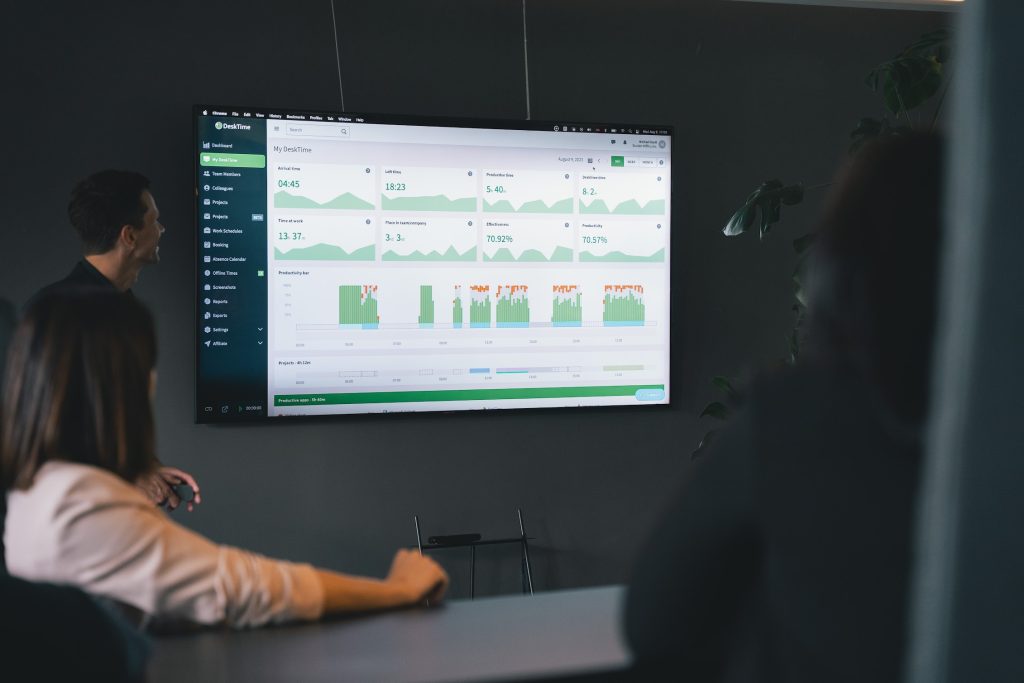Project Time Tracking Software: The Best Apps for Time and Project Management
Project time tracker software is essential for any team aiming to boost productivity, efficiency, and stay aligned with project timelines. With the right project time tracking app, you can monitor how time is spent on various tasks and projects. Whether you manage teams for a large corporation or a small business, you’ll find it necessary to use project time tracking software. After all, you and your team members cycle through multiple tasks and projects throughout the day. Tracking time spent on those activities is crucial to pinpointing inefficiencies and identifying areas of improvement.
But you might be wondering what project time trackers are exactly and how they go beyond identifying problems to delivering useful insights for your team. In this article, we’ll break down project time tracking software and how it can improve your team’s performance. We’ll also offer practical tips on how to integrate these tools into your work routine so you can lead by example.
Article outline
- What is project time tracking software?
- How do you track time in a project?
- What features should you look for in a project time tracker?
- What to consider when choosing a project time tracking tool for your team
- What project time trackers are available and how do they differ?
- Best Project Time Tracking Apps in 2024
- How project time tracking software can improve your team’s performance
- How to implement a project time tracker into your work routine
- How to use a project time tracker: 6 tips and tricks
- Project Time Tracker Software Integrations with Other Project Management Tools
- Leverage project time tracking software for a more effective team
- FAQ – Project time tracking
Want to get the most out of your time?
Try DeskTime for free!
Try free for 14 days · No credit card required.
By signing up, you agree to our terms and privacy policy.

What is project time tracking software?
Project time tracking software are tools that help teams and individuals record and monitor the time they spend on tasks, projects, and other activities. Key features include time entry, project management, reporting and analytics, invoicing and billing, and team collaboration.
Using project time tracking software helps you identify the tasks that employees spend the most time on. This helps you accurately estimate how long it will take to complete a project so you can establish realistic goals and design an effective workflow for your team.
How do you track time in a project?
You can track time in a project by using a project time tracker or timesheets. Project time tracking software provides automatic time tracking. Conversely, with timesheets, employees have to manually enter their time by using a tool like Google Sheets.
Of the two options, using project time trackers is ideal. This is because automatic time tracking leads to more accurate time reports and increases employee efficiency.
To track time in a project time tracking tool, first create a project. Software like DeskTime include “project” tabs and a way to create, name, and add details to the project. From there, add tasks and start tracking task time by either clicking the timer button or manually entering the time. Later, you can choose to view reports on team members to identify trends in their productivity.

What features should you look for in a project time tracker?
When choosing a project time tracker for your team, there are certain features you should focus on. Here are five of them:
- Accurate time tracking: Your project time tracker should accurately track employee clock in and out times, what they do online, and their idle time to determine productivity levels.
- Reporting and analytics: Detailed reporting and analytics will help you identify where your employees spend the most time and how to improve their efficiency.
- Project and task management: You and your team will work on various projects and tasks, so it’s critical to select a tool that allows you to easily organize, assign, and monitor those activities.
- Integrations: For effective workflow management, your project time tracker should integrate seamlessly with collaboration, communication, and invoicing tools.
- Team collaboration: Choose a project time tracker that facilitates effective team collaboration through communication, task assignment, and project update features.
What to consider when choosing a project time tracking tool for your team
When selecting project time tracking software, it’s essential to assess your business needs, team size, and management model (in-house, remote, or hybrid). A project time tracking app should support both individual and team-based workflows, whether for small or large groups. Additionally, ensure that it offers scalable features at a price that aligns with your budget. Robust reporting and integration capabilities are also key factors to optimize your team’s efficiency and project oversight.
What project time trackers are available and how do they differ?
There are many project time tracking apps and tools to choose from. Below, we’ve listed a few options that will help your team maximize their time and manage projects effectively.
- DeskTime: Provides comprehensive time tracking and productivity monitoring for improved employee efficiency and enhanced task management.
- Toggl Track: Offers intuitive time tracking and extensive integrations so users can streamline projects and tasks across platforms.
- Harvest: Combines time and expense tracking for detailed project cost management and enhanced productivity.
- Clockify: Features robust team collaboration tools and detailed project time tracking to manage and optimize workflows.
- Hubstaff: Offers comprehensive employee monitoring and time tracking to effectively manage projects and distributed teams.
Best Project Time Tracking Apps in 2024
DeskTime
DeskTime provides automatic time tracking with features for productivity analysis, project tracking, and employee monitoring. It offers real-time reporting and helps teams improve efficiency.
Integrations: Trello, Asana, Jira, Google Calendar, Outlook.
Best known for: Automatic time tracking and productivity insights.
Best for: Businesses aiming to optimize productivity and track project performance.
Price: Starts at $7/month per user.
Capterra rating: 4.6/5
Toggl Track
Toggl Track offers easy-to-use manual and automatic time tracking, alongside in-depth reporting and project management features. It’s ideal for tracking billable hours and improving productivity.
Integrations: Slack, Asana, Jira, Trello, Zapier.
Best known for: Intuitive time tracking and simple project management.
Best for: Freelancers and small to medium-sized teams.
Price: Free for basic version; paid plans start at $10/user per month.
Capterra rating: 4.7/5
Clockify
Clockify is a robust project management time tracking software offering unlimited free time tracking for tasks and teams, along with features like timesheets, reports, and project budgeting.
Integrations: Trello, Jira, Asana, Slack.
Best known for: Offering a completely free version with unlimited users.
Best for: Large teams looking for a free, scalable time tracking solution.
Price: Free plan available; paid plans start at $4.99/user per month.
Capterra rating: 4.7/5
Hubstaff
Hubstaff includes time tracking, employee monitoring, GPS tracking, and payroll features, making it ideal for remote teams and field workers.
Integrations: Trello, Asana, Jira, PayPal.
Best known for: Advanced employee monitoring, including GPS tracking.
Best for: Remote and field-based teams needing time and location tracking.
Price: Starts at $7/user per month.
Capterra rating: 4.6/5
Harvest
Harvest offers time tracking with integrated expense tracking, invoicing, and project management. It helps teams streamline workflows and manage project budgets effectively.
Integrations: Asana, Trello, Slack, Zapier.
Best known for: Expense tracking and invoicing capabilities.
Best for: Teams needing time and expense tracking combined with project management.
Price: Free for 1 user; paid plans start at $12/user per month.
Capterra rating: 4.6/5
How project time tracking software can improve your team’s performance
Using a project time tracker improves your team’s performance in several ways. Here are a few:
- Enhances productivity: Project time tracking software provides detailed productivity reports so teams can identify time-wasting activities and reduce them in the future.
- Optimizes resource allocation: Managers can better allocate resources across teams once they understand how much time a task or project takes.
- Streamlines communication and collaboration: Project time trackers help team members work together more effectively by enabling information sharing, task delegation, and project tracking.
- Refines performance evaluation: Managers can use time-tracking data to objectively evaluate employee performance, which will also help them assess and address team training needs.

Be smart about your time!
DeskTime can help your team excel!
How to implement a project time tracker into your work routine
Before implementing a project time tracker into your routine, you should first establish clear goals. Think about why you want to adopt the software and what you hope to achieve. For example, you might want to prevent bottlenecks or improve team collaboration.
After deciding that, choose the best project time tracking software for your company. Consider the size and needs of your organization as well as desired software features. For example, Toms Panders, the co-founder and CEO of optimization platform Setupad, chose to use DeskTime for his company because of the tool’s app and URL-tracking and productivity reports.
Once you’ve decided on a tool, communicate its value to employees and train them on how to use it. Then, analyze the results of adoption and adapt your approach as your business grows.

How to use a project time tracker: 6 tips and tricks
Here are some quick tips on how to use a project time tracker effectively.
- Tailor the software to your work style: Customize your project time tracker’s project structures, time tracking intervals, and task categories to suit your workflow.
- Organize time around clients and projects: Match activities to specific clients, projects, and milestones. That way, you can understand data in time reports and gauge your productivity in terms of deliverables.
- Use project tags: Categorize your time by task type like meetings, writing, research, and more so you can filter time reports and generate detailed invoices for clients.
- Start a new timer for a new task: Instead of lumping tasks under one entry, start a new timer when switching between activities. This will help provide granular data for better work insights.
- Estimate time when you forget to use a timer: If you forget to start or end your timer, approximate how long you spent on the task (or, on DeskTime, check your tracked time) and manually enter the data so you don’t underreport your time.
- Audit time for accuracy: Each week, audit your time entries to ensure you’ve matched the right entry to the appropriate project. This will ensure accurate time and productivity reports.
Project Time Tracker Software Integrations with Other Project Management Tools
Project time tracker software seamlessly integrates with a variety of popular project management tools to streamline workflows and enhance team collaboration. These integrations enable time tracking directly within the platforms your team already uses, improving efficiency and reducing the need for switching between multiple tools.
For example, many project time tracking apps integrate with tools like Trello, Asana, and Jira, allowing teams to track the time spent on tasks and projects without leaving their preferred project management environment. These integrations typically involve the ability to start/stop timers, log hours, and generate reports within the project management tool itself, making it easier for managers to monitor progress and ensure tasks are completed on time.
Other common integrations include communication tools like Slack and Microsoft Teams, where time tracking notifications can be sent, and accounting tools like QuickBooks for invoicing and payroll management based on tracked hours. These integrations provide a comprehensive view of project workflows, from time management to billing and performance analysis.
Integrating project time tracker software with project management tools enhances the overall project management process by offering real-time insights into productivity, better resource allocation, and improved team collaboration.
Leverage project time tracking software for a more effective team
Whether you want to prevent bottlenecks or improve team communication, project time tracking software can help you and your team streamline your workflows and accomplish goals. These tools provide valuable insights into your team’s productivity and allow employees to collaborate more efficiently. So, adopt project time trackers into your work routine and relish the results.
Keep in mind, though, that your project time tracking approach can—and should—change as your company and team evolves. Remain flexible, stay on top of software updates, and even switch to more suitable tools to ensure your organization and team continue to flourish.
FAQ – Project time tracking
What is project time monitoring?
Project time monitoring refers to tracking and analyzing how much time is spent on different tasks and activities within a project. It helps teams identify inefficiencies, allocate resources more effectively, and improve overall productivity. By using project time tracker software, managers can track the progress of projects and make data-driven decisions to keep tasks on schedule.
How do you track time in a project?
Tracking time in a project can be done using a time tracking app. These tools allow teams to monitor time spent on specific tasks, projects, or activities either through automatic tracking or manual entries. By using a timer or timesheets, team members can log hours worked, and managers can review this data to ensure project goals are met within the set deadlines.
What does project time tracker software do?
Project time tracker software helps teams track, manage, and analyze the time spent on different tasks and projects. It records the time spent on each activity, generates reports, and provides insights into team productivity and efficiency. This software also helps in resource allocation, budget management, and identifying areas for improvement in the project workflow.
What tools track project hours?
Software such as DeskTime, Toggl Track, and Clockify, are popular tools for tracking project hours. These project time tracking solutions allow users to monitor time spent on tasks, generate reports, and optimize workflows. They also integrate with project management platforms, helping teams stay organized and efficient.
How can a project time tracking app improve the project management process?
A project time tracking app improves the project management process by providing real-time data on how time is allocated to different tasks. These insights allow project managers to identify inefficiencies, reassign resources, and optimize workflows. Additionally, project time tracking apps streamline communication and collaboration, making it easier to stay on top of project timelines, budget constraints, and team productivity.
Did you find this article useful? Give it a clap!
Psst! You can clap more than once if you really loved it 🙂